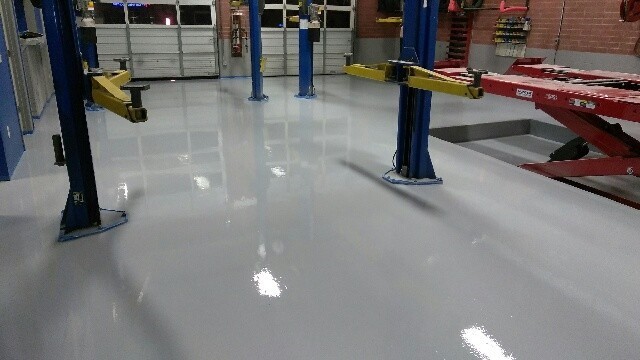
There is no lack of choices with regards to substantial floor coatings. These materials are by and large used to safeguard hidden substantial floors from wear as well as forestall the erosion of steel reinforcement. Generally speaking, floor coatings can likewise be utilized to:
Epoxy Floor Coatings
Epoxy floor coating construction chemicals are comprised of two unmistakable components: an epoxy pitch and a polyamine hardener. These two parts are blended before application. At the point when the tar and the hardener are joined, they participate in a chemical response that makes cross-connecting of the components as it fixes. The consequence of the chemical response is a solidified, unbending plastic coating material that bonds well to most base layers.
Epoxy floor coatings are known for their hardness, toughness, and effective opposition. These attributes make epoxy coatings ideal for hardcore applications like modern offices, stockrooms, calculated focuses, and different regions that might be exposed to weighty forklift traffic. Epoxy is additionally known for its protection from chemical items, like dye, oils, lubes, cleaners, and so on. This chemical opposition goes with them a well-known decision in carports in the car business.
One of the primary inconveniences of epoxy floor coatings is their troublesome application process. The surface arrangement, specifically, can be drawn-out. Epoxy flooring can’t be applied to defiled, harmed, or ill-equipped surfaces. To guarantee coating life span, the floor should be liberated from any oil, oils, or solvents. Harmed surfaces should likewise be fixed, and the substances may be ground to open up their pores and profile the surface. Furthermore, this material requires roughly seven days to fix; hence, epoxy floors have an essentially more slow turnover time than different coatings.
Polyurethane Floor Coatings
Polyurethanes are polymers that are associated with a chemical compound gathering known as carbamates. Polyurethane is a thermosetting polymer ordinarily; i.e., it doesn’t liquefy when warmed. To the undeveloped eye, polyurethane coatings might give off an impression of being outwardly like epoxy-covered floors. Nonetheless, they have unmistakable qualities that make them ideal for explicit applications.
Not at all like epoxy coatings, which are profoundly firm and effect safe, polyurethane floor coatings are moderately milder and more versatile. This characteristic improves polyurethane floor coatings appropriate for regions with moderate to the weighty person on foot traffic. The expanded flexibility likewise makes polyurethane-covered floors more impervious to scraped spots, since influence loads are effortlessly assimilated and less inclined to cause scratches. The versatility and adaptability of polyurethane additionally add to its capacity to work in conditions with low frosty temperatures.
The helpful qualities of polyurethane floor coatings make them ideal for a few applications, including vehicle leaves, freezing chambers, and occupied business offices, like shopping centers, air terminals, and clinics.
One of the other critical benefits of polyurethane Industrial Floor Coating is its restoring time. Floors covered with this material can be prepared for activity the following day. Interestingly, epoxy coatings need no less than seven days to fix before they can be prepared for use.
While polyurethane has numerous useful properties, they do have a couple of deficiencies. Right off the bat, polyurethane floors are profoundly delicate to dampness. At the point when dampness goes after the floor, air pockets can shape on a superficial level, causing unattractive imperfections on a superficial level. Polyurethane floor coatings are, along these lines, not suggested for use in regions with elevated degrees of stickiness. Their restricted pot life and dampness responsiveness additionally make them trying to work with. Thusly, the legitimate dealing with and utilization of polyurethane coatings normally require thoroughly prepared and educated staff.
Polyaspartic Floor Coatings
Polyaspartic is a subset of polyurea. Like polyurea floor coatings, polyaspartic is a two-section framework, i.e., the sap should be joined with an impetus to work with the relieving and solidifying process. While early varieties of polyaspartic floor coatings had a few weaknesses, developments in coating innovation have made these floor coatings a flexible choice for epoxy and polyurethane coating frameworks.
One of the essential advantages of polyaspartic is its capacity to be utilized as a total flooring framework as well as a top coat. All in all, polyaspartic floor coatings can accomplish in a solitary coat what conventional epoxy and polyurethane would regularly take two coats to achieve. Therefore, polyaspartics can fundamentally lessen application times, and work and material expenses.
One more advantage of polyaspartic floor coating is their capacity to be modified. Polyaspartic esters can be controlled to control drying times and pot life. This trademark reduces the slack time and permits resources to be returned to support quicker. Some coating details can dry very quickly, with the following day return to support.
Acrylic Floor Coatings
Most acrylic floor coatings are made with more than one monomer, for example, ethyl acrylate, methyl methacrylate, or butyl acrylate. These parts are much of the time handled in a dissolvable, generally water. These floor coatings offer a center ground concerning cost and execution.
Acrylic floor coating are not generally so sturdy as their epoxy or polyurethane partners. Accordingly, they might be polished or recoated more much of the time than different coatings. In this way, while the underlying expense of acrylic floor coating might be moderately reasonable, long-haul support costs will generally be higher than those for different coating.
While acrylic misses the mark on the solidness of other floor coating, they have somewhat quick relieving times, drying as quickly as an hour after application. This diminishes the general work necessities and completion times. Furthermore, the outer layer of the coating can be effortlessly polished on the occasion the coating becomes harmed during activity.
End
Substantial floor coatings offer remarkable properties and advantages that loan themselves to different applications. A few elements, like expected traffic, natural circumstances, and solidness prerequisites, should be painstakingly thought about to figure out which substantial floor coating item is generally proper for a particular venture.